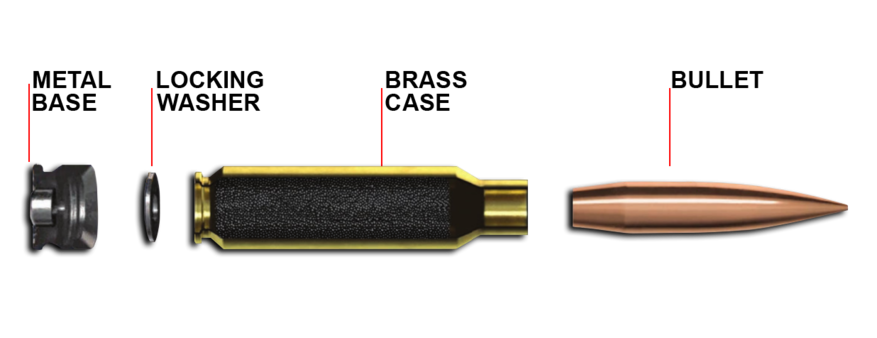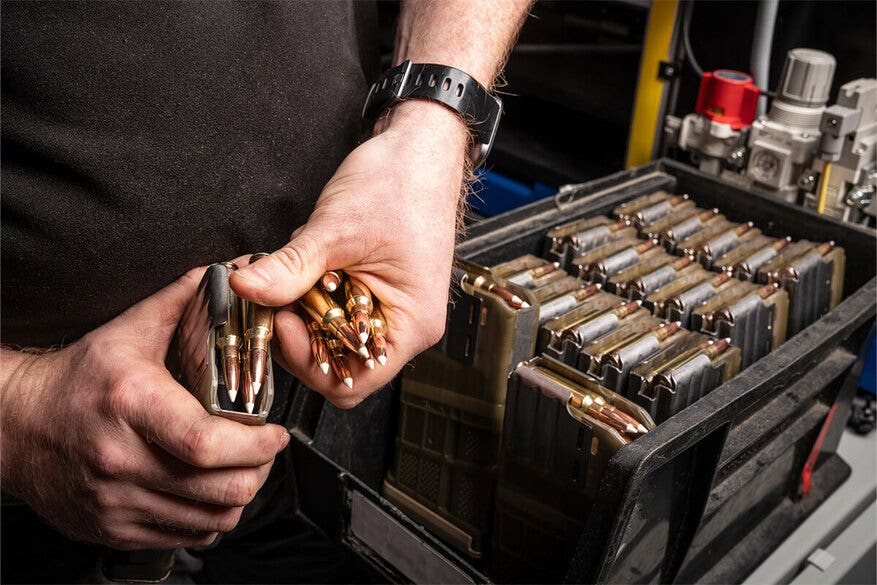In the news off and on for over 5 years, the hammer has finally dropped and the US Army as choisen Sig Sauer’s .277 FURY as their new cartridge for the NGSW program!
What does this mean for the venerable M4? Is the AR-15 dead? Are we all going to switch to 6.8mm? Let’s talk about it.

Important History
You might be wondering where this all came from, thankfully the answer is pretty simple.
Back in 2017 the Army did a study called the Small Arms Ammunition Configuration Study and that study concluded that while the M4 was a great rifle, it and 5.56 NATO did not have the punch required to defeat near-peer (Russian and Chinese most likely) armor at long range.
At least, that is what we’ve been told that the study says. The study itself is still classified, so we’re not exactly sure what it exactly says.
The study, we’re told, concluded that a new ammo type was needed, that it should be 6.8mm, and that a new rifle system would be required.
Based on this information the Next Generation Squad Weapon Program was started in 2018.
The requirements for the program haven’t been released to the public, but snippets of information have come out. Basically, the Army wanted a 6.8mm cartridge that could defeat near-peer armor at 500 meters.
Many entered, a few were selected, but the final winner was recently announced as being Sig Sauer with their XM5 rifle, XM250 LMG, and the .277 SIG FURY (6.8x51mm) cartridge.
The XM5 is Sig’s MCX Spear rifle (basically a MCX Virtus scaled up from 5.56 NATO to 6.8x51mm) and the XM250 is Sig’s MG-338 that SOCOM is testing but scaled down a little from .338 Norma Magnum to 6.8x51mm.
But enough with that stuff -- let’s talk cartridge.

.277 Fury/6.8x51mm Is Not 6.8 SPC
For some reason, some sources have started to claim that 6.8 SPC is the same thing as what the Army just adopted.
This is wrong. Very wrong. Not even remotely close to being true in any known realm of reality.
Just to be clear here -- 6.8 SPC is 6.8x43mm and is designed for the AR-15. .277 Fury, the cartridge that was just adopted, is 6.8x51mm and is much too large to fit in a standard AR-15 frame.
Ballistics
The 6.8x51mm is a horrible name in my opinion. Thankfully, Sig submitted the design to SAAMI under the name .277 SIG FURY and that’s much cooler.
.277 SIG FURY is a really… odd cartridge.
Right off the bat it has two things that REALLY make it stand out -- first, it’s a bi-metal case. The base is made from stainless steel and the body is made from brass. The two use a locking washer to mate together.
The other thing is that according to Sig and the Army 6.8x51mm has a chamber pressure of 80,000 PSI.
To put that into context, very few cartridges go over 60-62k PSI. 5.56 NATO is 62k PSI (NATO method) and 7.62x51 NATO is 60.2k PSI (NATO method).
That means .277 SIG FURY having 18-20k PSI higher is… a lot. Like, a HUGE lot.
That pressure, according to the Army and Sig, means .277 SIG FURY shoots a 140gr bullet at 3,000 FPS from a 16” barrel. That’s wicked cool.
Ballistically, I think this is easiest for us to picture it as basically a magnum version 6.5 Creedmoor.
Side by side there are a lot of similarities, just that .277 SIG FURY is juiced up.
Check out this chart:

The chart makes it clear, .277 SIG FURY has a huge advantage over a lot of common cartridges when it comes to drop.
To make this even clearer, here is a chart:
|
Cartridge |
Barrel Length |
Bullet Weight |
Muzzle Velocity |
Energy @ 100y |
Energy @ 500y |
Drop @ 500y |
|
.277 SIG FURY |
16" |
140gr |
3,000 FPS |
2,529 ft.lbf |
1,654 ft.lbf |
-41 inches |
|
6.5 Creedmoor |
24" |
140gr |
2,710 FPS |
2,056 ft.lbf |
1,317 ft.lbf |
-53 inches |
|
.300 Win Mag |
26" |
180gr |
2,960 FPS |
2,947 ft.lbf |
1,378 ft.lbf |
-52 inches |
|
.308 Winchester |
24" |
168gr |
2,700 FPS |
2,356 ft.lbf |
1,264 ft.lbf |
-59 inches |
|
5.56 NATO |
16" |
62gr |
2,800FPS |
1,080 ft.lbf |
512 ft.lbf |
-54 inches |
If the Army goes through with their plan .277 SIG FURY is going to replace the M4 and M855A1 cartridge.
Ballistically, these aren’t remotely comparable. However, it should be noted that we are comparing an intermediate cartridge with a full-sized cartridge. Adopting .277 SIG FURY basically means we’re going back to the days of big cartridges.
If that is actually a gain for our warfighters… well, that’s for another article.
Regardless, speaking purely in terms of ballistics -- .277 SIG FURY is a beast.
6.8x51 vs. 5.56
Ballistics
As you can see from the charts above, the comparison between 5.56x45 and 6.8x51 is not close ballistically. Consider the starting velocities and bullet energies. A 140 grain projectile is more than twice as big as a 62 grain. Obviously true. Now add to it that 6.8x51's bullet exits the muzzle at 3,000 fps which is 200 fps faster than 5.56. These are rather generic velocities and averages but will suffice for what we’re doing.
Those two measurements have a direct bearing on bullet energy. At the muzzle, the 5.56 shows 1080 ft/lbs of energy, while the 6.8/277 shows just shy of 2,800. Look on down to 500 yards. The 5.56 has fallen to just over 1,900 fps with 512 ft/lbs of energy and dropped about 54 inches, not quite 5 feet. Compare that to the 6.8x51 at 2,091 fps and about 1,400 ft/lbs, with a drop of only about 46 inches. Remember… this smaller drop is accomplished with a bullet over twice as heavy as that of the 5.56mm.
It’s no wonder that our soldiers will most likely be glad to get this cartridge. It will speak with far more authority than the current 5.56mm and will enable meaningful hits on targets at ranges up to and past 500 yards. The 6.8x51 has more energy remaining at 1,000 yards than the 5.56 does at 500.
Recoil
This will be quick. What are the recoil energies for the pair, given the data above? 6.2 ft/lbs for the 5.56 and almost 19 for the 6.8x51. These are more “guesstimates” than hard facts, but I went with what numbers I could find. Suffice it to say, the 6.8x51 will kick a lot harder than the 5.56.
Weight
Also, consider the weight of loaded ammo. The 6.8x51 will weigh approximately three times what a similar number of 5.56mm rounds weigh. That cuts down on the amount a warfighter could carry on the battlefield. I don’t know for sure, but I would imagine the Army powers-that-be are hoping that the 6.8 will be more effective and require fewer rounds than the 5.56 to get a particular job done.
Chamber Pressure
As for chamber pressure, the civilian .223 is loaded to (psi) 55,000. The 5.56x45 NATO goes up to 58,000. The winner? The 6.8x51, at a whopping 80,000 psi. SAAMI gave special dispensation to allow this high number… no other commercial cartridge is so loaded. Even the .338 Lapua tops out at around 61,000. All this means that the .277 Fury is king of the pressure hill.
6.8x51 vs. .308
Ah… here, the difference isn’t so clear-cut. The difference between the two is less than that of the 6.8x51 and the 5.56. You have the same case dimensions for both (even though the 6.8 is a hybrid case), so the powder capacity is roughly the same. You have a bullet diameter difference of .239 inch… .308 minus .277. The cartridges should be pretty similar, right? You’d think so.
Take a look again at the chart above comparing 6.8x51 (.277 Fury) and some other common cartridges. All five are fairly close at 400 yards, but then things start to happen. Cutting to the chase, the (purple line) .308 shows a final drop at 900 yards of about 25 feet, while the (green line) .277 Fury drops about 16 feet at that distance. Given the fact that the Fury’s bullet started at around 3,000 fps, it isn’t rocket science to figure that the bullet from that rifle would retain energy and show less drop than any of the other calibers shown here. The ballistic coefficient of .277 Fury's 140-grain bullet is higher than that of the .308 so it will hang on to velocity at longer ranges.
This chart reflects the main advantage the .277/6.8x51 has… oomph. That’s a "technical term" for lots of velocity and lots of energy at ridiculous ranges. The .308 is used as a sniper rifle, but with the advent of this baby, I can see military agencies making the switch. I mentioned above that the Fury is designed to defeat modern body armor at 500 meters. This would give our military a huge bonus, which leads me to the last section…
What .277 Fury Means For You

Right now -- probably nothing.
The Army wants to replace at least part of its inventory of M4 carbines and M249 Squad Automatic Weapons with their Sig counterparts. This is slated to start occurring by October of this year. But, not all the 5.56mm weapons will be gone. From what I read, the Army is only issuing the new 6.8s to actual combat troops. Rear-area and other non-front-line troops will still carry the M4.
Production for this new cartridge is very low and very slow. What little Sig is producing is almost all going to military testing. Other brands can make it if they want, but so far almost no one is.
Lake City, the military’s ammo manufacturing plant, is gearing up to produce 6.8x51mm but that won’t be online until 2023/2024. After that, Sig will become the secondary source for ammo to the military.
When it does become more available I’m still not sure what role it might fill.
It won’t be cheap to shoot, surely not cheaper than .308 Win or 6.5 Creedmoor.
While it will be ballistically better than 6.5 Creedmoor, I’m not sure that it is better enough for it to really matter for most of us.
Using the generalization that you need 2,000 FPS and/or 1,000 ft.lbf for hunting ethically, .277 Fury delivers that out to 800 yards. 6.5 Creedmoor delivers that to about 600 yards.
200 more yards might sound cool, but even 600 yards is way outside most people’s personal limits for hunting.
I’m sure there will be an appeal for what is effectively a 6.5 Creedmoor Magnum, but I’m not sure that it will actually replace or change much for the majority of us.
That said -- I still totally plan on getting one when I can.
Is The AR-15/M4 Becoming Obsolescent?
No. It is not. There are a lot of reasons why so let’s talk about it.
The Army is looking to replace their M4s and M249s for warfighting reasons. But they’ve also been trying to do that for a long, long time. Nothing has ever come of it. Yet.
Personally, I doubt that the Army will get rid of the M4 in my lifetime. The platform is too useful, too good, and too cheap.
Even if the Army does, that won’t change anything for the average AR-15 owner. While there is no debate that 5.56 NATO struggles at range, no average home defender is needing to punch through space-age body armor at 500 meters.
For 99% of people facing 99% of problems, the AR-15 is and will remain the most practical and useful platform.

Wrapping Up
There is still a lot of speculation in the air about .277 SIG FURY, the XM5, the M4, and a lot more. For now, nothing is really happening except that the Army is spending a ton of money to test things out.
For now, business as usual for most of us. But give it a few years and we might be in for a big shake up.
[While you're here, check out our selection of AR-15, AR-10, and AR-9 rifles, uppers, barrels and more! We manufacture 16 calibers of pistols and rifles here in Sanford, NC and cut out the middle man to pass on the savings to you. Shop your next build here!]











